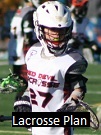Template:Handling High Pressure Defense - 3 Man Press on Adjacents
From Lacrosse Plan Drills
Handling High Pressure Defense - 3 Man Press on Adjacents
- Attack the attacker. Running away from pressure will not help the cause. Teams that assume a defensive offensive posture against an aggressive defenseman will be playing into the opponents' defensive strategy.
- Emphasize short passes. The offense should focus on 7-10 yard passes (maximum). The idea is to be active off the ball and run all the way through the ball while recovering a pass.
- Run as fast as you can against pressure - simple advice, often forgotten.
- Communicate. Whenever a double team is initiated, the offensive men should understand that one of them will be free. The players should communicate such information with simple, easily recognizable terms.
- Make them pay. The most effective tool against a high-pressure defensive is to score. Any time a team overextends its defense, a score will make them pull back on their pressure.
- Stickwork. There is no better foil against high-pressure defense than solid stickwork. Daily stickwork drills are a must for every program.
Drills:
All drills should be designed to make the situation harder than it would be in a game. Situations are endless, but here are two that have proved effective:
- Drill 1, 6 vs 7 Long Poles, Drill the goalies to hold the ball vs pressure for two minutes inside the restraining box.
- Begin the drill with six offensive players controlling the ball inside the offensive restraining box against six defensive players, each playing his offensive man tightly, denying the adjacent pass.
- After 40-45 seconds of ball movement, the coach should release an extra man to double the ball or to provide additional pressure on an off-ball player.
- Drill 2, Bingo Drill
- Objective: To touch the ball into the restraining box against a double team, then locating the two-onone situation backside from the double-team.
- M1 (with ball) starts at midfield against defenders DM1 and LP1. The doublers do not play head-up at the start of the drill and work to a pinching position.
- M1 must run as fast as he can to the corner of the restraining box, establishing a 10-second count. This releases M2 and M3 from the midfield line, who break toward the ball-carrier (M1).
- D2 goes with M2 and M3, covering them on the backside.
- As M1 makes his run away from the double (DM1 and LP1), the open M2 or M3 calls "Bingo!", indicating his opponents, and M1 hits the open man (in this instance, M3) with a short pass. D2 must fill in on the backside of the ensuing 2-on-1 (DM1 and LP1) vs M3.
